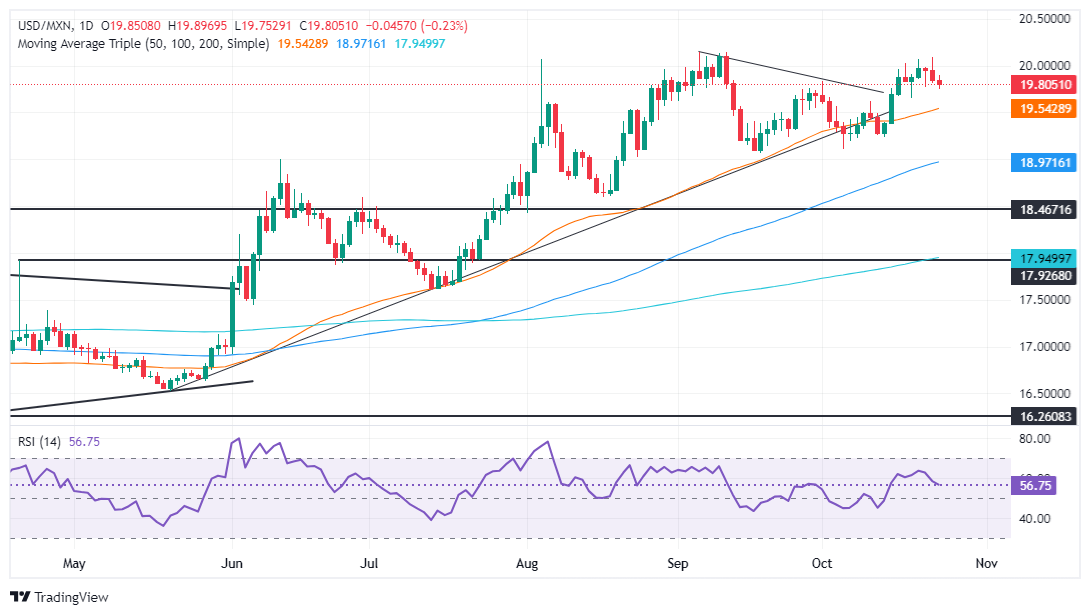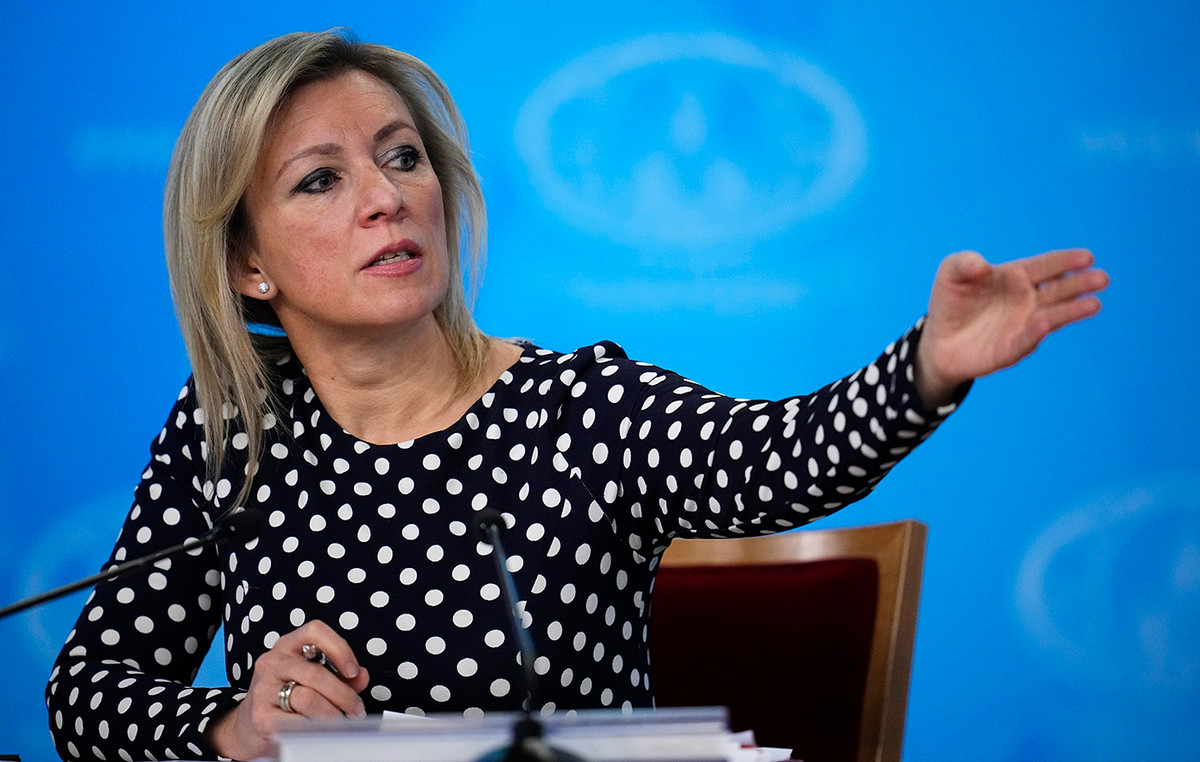- The Mexican Peso consolidates while Mexico’s general inflation rises slightly in early October.
- The IMF projects Mexico’s GDP growth of 1.5% in 2024, compared to a stronger forecast of 2.8% for the US economy.
- Strong US employment data and improving PMI numbers support the US Dollar.
The Mexican Peso remains firm against the Dollar during Thursday’s North American session amid an improvement in risk appetite. Inflation in Mexico rose slightly in the first 15 days of October, while employment data in the US was solid, supporting the Dollar. At the time of writing, USD/MXN is trading at 19.82, virtually unchanged.
The National Institute of Geography and Informatics Statistics (INEGI) revealed that Mexico’s general inflation accelerated in the first half of October. However, the underlying rate moderated to levels not seen since February 2021. This reinforced expectations that the Bank of Mexico (Banxico) would reduce borrowing costs after economic activity and retail sales data for August suggested that the economy was losing ground.
International Monetary Fund (IMF) projections suggest that Mexico’s economy is expected to grow 1.5% in 2024 and 1.3% in 2025. In contrast, the IMF revealed that the US economy will achieve growth of Gross Domestic Product (GDP) of 2.8% in 2024 and 2.2% in 2025.
Additionally, a strong labor market report from the U.S. Department of Labor revealed that the number of Americans filing unemployment claims in the week ending Oct. 19 was lower than expected.
Recently, S&P Global revealed that the manufacturing and services PMI in October improved, although the former remained in contraction territory. This raised the composite PMI from 54.0 to 54.3, a tailwind for the Dollar.
Earlier, the Cleveland Fed’s Beth Hammack said core inflation has moderated but is still not at the 2% target, adding that prices had cooled amid a strong labor market and “good growth.” He stated that it is reasonable to expect more disinflation.
Daily Market Summary: Mexican Peso Wavers Amid Mixed Inflation Readings
- The inflation report for the first half of October in Mexico was 4.69% year-on-year, above the expected 4.65% and the previous reading of 4.66%. Core inflation data increased by 3.87% year-on-year, below the 3.95%, although it did not reach the expected 3.82%.
- In monthly terms, inflation for the first fortnight rose 0.43% month-on-month, exceeding the previous reading of 0.09% and estimates of 0.40%.
- Monex analysts suggested that the latest inflation data could prevent Banxico from reducing rates in upcoming meetings. The next Banxico meeting is on November 14.
- Initial jobless claims for the week ending October 19 increased by 227,000, below estimates of 242,000 and the previous reading of 241,000.
- The S&P Global Manufacturing PMI for October was 47.8, up from 47.3 in September and beating estimates of 47.5. The services PMI improved from 55.2 to 55.3, above the 55.0 projected by analysts.
- Data from the Chicago Board of Trade, via the December federal funds rate futures contract, shows that investors are estimating a 48 bp reduction from the Fed by the end of the year.
USD/MXN Technical Outlook: Mexican Peso Consolidates Below 20.00
The bullish trend of USD/MXN remains intact, although it has consolidated within the range of 19.80-20.00. The momentum shows that sellers have intervened with the Relative Strength Index (RSI) pointing lower, limiting the exotic pair’s advance.
If buyers break 20.00, they could test the weekly peak at 20.09. With further strength, USD/MXN could aim towards the year-to-date (YTD) high at 20.22, ahead of the key psychological levels of 20.50 and 21.00.
On the other hand, if sellers reclaim the October 18 low at 19.64, this could pave the way for a challenge to 19.50. The next move would be towards the October 4 low of 19.10 before testing 19.00.
The Mexican Peso FAQs
The Mexican Peso (MXN) is the most traded currency among its Latin American peers. Its value is largely determined by the performance of the Mexican economy, the policy of the country’s central bank, the amount of foreign investment in the country and even the levels of remittances sent by Mexicans living abroad, particularly in the United States. . Geopolitical trends can also affect the MXN: for example, the nearshoring process (or the decision by some companies to relocate manufacturing capacity and supply chains closer to their home countries) is also seen as a catalyst for the currency. Mexican, as the country is considered a key manufacturing center on the American continent. Another catalyst for the MXN is oil prices, as Mexico is a key exporter of the raw material.
The main objective of Mexico’s central bank, also known as Banxico, is to keep inflation at low and stable levels (at or near its target of 3%, the midpoint of a tolerance band between 2% and 4%. %). To do this, the bank establishes an appropriate level of interest rates. When inflation is too high, Banxico will try to control it by raising interest rates, which makes borrowing more expensive for households and businesses, thus cooling demand and the economy in general. Higher interest rates are generally positive for the Mexican Peso (MXN) as they lead to higher yields, making the country a more attractive place for investors. On the contrary, lower interest rates tend to weaken the MXN.
The publication of macroeconomic data is key to evaluating the state of the economy and can have an impact on the valuation of the Mexican peso (MXN). A strong Mexican economy, based on high economic growth, low unemployment and high confidence is good for the MXN. Not only does it attract more foreign investment, but it may encourage the Bank of Mexico (Banxico) to raise interest rates, particularly if this strength is accompanied by high inflation. However, if economic data is weak, the MXN is likely to depreciate.
As an emerging market currency, the Mexican Peso (MXN) tends to rise during periods of risk, or when investors perceive overall market risks to be low and are therefore eager to engage in investments that carry higher risk. . Conversely, the MXN tends to weaken in times of market turbulence or economic uncertainty, as investors tend to sell riskier assets and flee to more stable safe havens.
Source: Fx Street
I am Joshua Winder, a senior-level journalist and editor at World Stock Market. I specialize in covering news related to the stock market and economic trends. With more than 8 years of experience in this field, I have become an expert in financial reporting.








